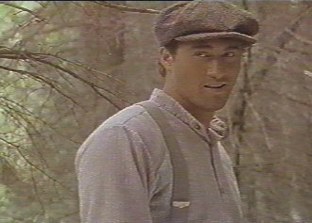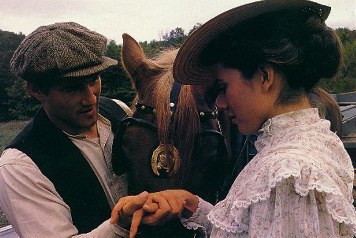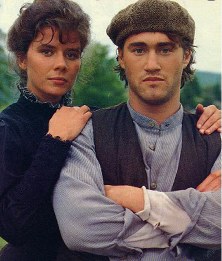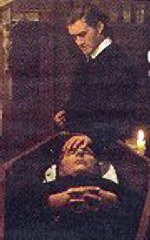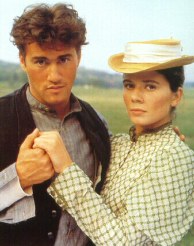
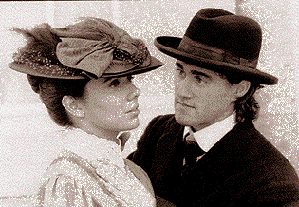



TV series directed by Jean Beaudin.
Based on the novel of Arlette Cousture, the TV series related a slice of the life of a young country school teacher, deep in rural Québec at the beginning of the 20th century. From her teens to her mid-thirties, we will follow Emilie Bordeleau’s fate. A life that will be devoted between two loves : teaching and her passion for Ovila Pronovost. We will be present when love is born, a love bigger than themselves, attaining its climax to finally end up in an inescapable outcome.
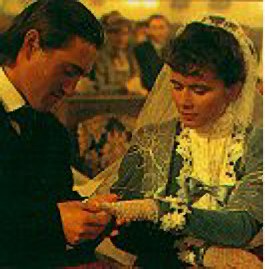
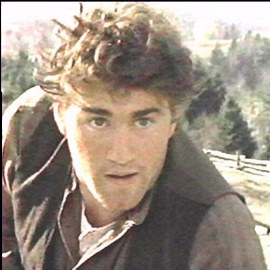
Spring of 1990
While lining up at Steinberg’s cashier, I automatically picked up a TV Hebdo ( Québec TV Guide) just to kill time. I came
across an article on the controversy in the casting for the role of Émilie, being directed by Jean Beaudin from Cousture’s
best seller. I could not imagine selecting Marina Orsini for Emilie’s role (but I was proven wrong, because she gave us a
beautiful Emilie). I did not care so much for Lance et Compte and I had not seen l’Or et le Papier. So I was sharing the
majority of people who has in mind somebody else to play the school teacher whom we had imagined when reading
the novel. I had no idea as to who would be best to play this character, but I was happy to see Beaudin as the director.
It made my day, when I read that Roy Dupuis had been casted for the role of Ovila. I must have jumped up in the air
as I was so happy to learn that. He would at last get a break where he was able to measure up to. I had still in mind his
presence in Un oiseau vivant dans la gueule and was so thrilled just to think that he would be playing that role.
He would become the character’s alter ego. I could imagine him physically in the role of Ovila Pronovost. Insanely
in love with the wilderness and with Emilie. I was in agreement with his casting, giving a chance to the viewers
to appreciate his talents.
A lot can be said about Caleb’s daughters. It was a beautiful gift by Beaudin. A painting of our heritage. Everything is in there.
A perfect reflection of this era. It gives me vertigo. It is a real portrait of ourselves, the land and the scent from the land are
ours, mild and demanding. Jean Beaudin, I want to thank you.
Let me describe the work piece by piece, because it deserves such a treatment. First a word on the novelist. In Québec is
like a large family. The ties between us are knitted so tightly that often we are not even conscious about it.
I remember Arlette Cousture, the author of Caleb’s daughters, when she was in her twenties and our English teacher in third year of high school at Mont-de-la-Salle in Laval. I still picture her just a few years older than we were, with her long brown hair floating on her shoulders. She talked just about everything ; the West, the Inuits. She was a marvelous story teller. And if I do not remember much of her teaching of Shakespeare language but I have excellent memories of the stories that she told us.
First, let’s talk about the era, an era which is not too far away. It starts in the early 1890 when Emilie was a teenager.
My grandparents were born before the end of that decade. So it is not a so distant past and somehow I feel that I
belong to it. Québec came in late into the modern world and we remember dearly that time, reassuring for its traditions,
its wisdom, the happiness in the comforting company of the family, their daily support. Religion, the land, manual work,
the contact with nature, life and death, our ancestors austerity in which they lived, the close contact with the land which
saw them come to life and die. The intuitive knowledge about their environment and themselves. All these sentiments
were present in the series and I felt them deeply. The above description is an icon. I have read that many scenes were
filmed with a "Burnt Sienna" color filter. The whole series is nailed to the land, to the plant and animal life, the prairies
green in July, the sparkling white snow in December, the warm light that filters the head of tall maple trees in March,
the subtle yellow of October. The wind always blowing, the terrible wind of the North blowing in the snow and that
will also clear up the sky.
Beaudin is always sensitive to the wind, because he makes it his ally. Perhaps, he is playing Eole. I do not know all his secrets.
But this conniving wind also belongs to Emilie and Ovila when return from Telesphore funerals, when Ovila returns from work
to meet Emilie and the children, near the clothes line. Also, when Emilie and Berthe met for a final goodbye. The wind is
always present when it forces Emilie to give birth in the snow, it blows on the prairies when Ovila holds Emilie in his arms,
the summer before their wedding, it caresses Ovila’s face when he hear the call of his lover, Emilie, rushing down the pathway
to meet Ovila...We often forget the present of the wind because it is as natural as life and the air that make us and the land
breathe. Wind or no wind, it carries our moods just as the land carries us.

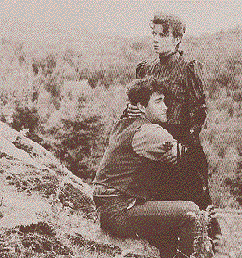
Sites and sets or the Art of supporting characters...
Filming locations of Les Filles de Caleb was the work of Jocelyn Joly, Luc Martineau was responsible for the
settings and Richard Grégoire for the music soundtrack.
The series was filmed around St-Jean-des-Piles in the Mauricie region nearby the villages where the novel's action took place.
The region is knowned for its forests, rivers, lakes and its skies. During summer, if weather is nice, the Mauricie will dress
up to look its best, wearing deep penetrating greens and blues that will make even Meditarranean skies to blemish.
Those greens and blues will mix together melting away in strong hues changing at each detour of the landscape,
celebrating Nature's strength and omnipresence. It is a peaceful land, yet powerful.
Peaceful because of its placid lakes, the serenity of its forest and of course because of the St.Maurice river, sometimes flowing slowly or rushing down furiously. A very important river for men who depended on her to earn a living. A strong land,
untamable, a gigantic forest at the doorstep of civilization. During a trip last summer to Shawinigan, I have witnessed
this phenomenon while on a top of the 115 meters tower. The town is besieged with a rich vegetation, like a leafy tide
invading the city. It is very impressive. The land seems to give man just enough space and not an inch more.
Ovila Pronovost comes from this land, an original product, a replica of the soul of the land.
I had also the privilege of browsing through the sets of Les filles de Caleb. First in 1994, four years after the series.
I have spent my summer vacations in Emilie's and Ovila's country, en route to the St.Maurice Wildlife Reserve where
we had leased a chalet for one week. So we paid a visit to Emilie's Village. Unfortunately, it has now closed down.
The Village's organizers had bought the sets from the TV series to install them in a location nearby the original settings,
giving the appearance of reality to the scenes as shown in my pictures on this page of the Pronovost house and also of the school..
The sets in this series are real, real buildings, not trompe-l'oeil. So it was with great emotion that I visited each building,
each room,admiring each object, searching for recognition, an approval, a smile from each treasure that I found.
As an added pleasure, Richard Grégoire original music was playing. This was a great idea as I am also sensible to
music as to the beauty of objects and nature. For long hours, I have enjoyed walking around the sites, that were still
full of life, like they were asleep during the absence of Émilie, Ovila and the others.
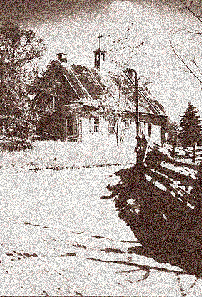 But it is in the schoolhouse where I lived the greatest emotion. Sitting down at Ovila's desk I could finally measure the classroom space. It was a really small room...and I still wonder how they have achieved filming
But it is in the schoolhouse where I lived the greatest emotion. Sitting down at Ovila's desk I could finally measure the classroom space. It was a really small room...and I still wonder how they have achieved filming the Christmas scene in such a small area.
Being there was adding another dimension and a most important one that cinema or television can not offer.
The smell and the touch...The schoolhouse had this good old wooden smell, which is still living, breathing,
shrinking in the winter and expanding when summer comes...
The perfume of the pages of an old book, of a fire lit may times in the turtle stove, was filling the room along with delicate aromas, coming from outside, from the bushes and scents from flowers in the surrounding fields.
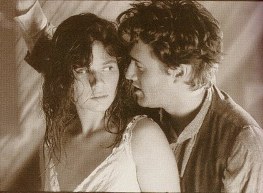
Again I was struck with a great emotion when going up the stairs to visit Émilie's bedroom. While climbing up slowly, I had the vision of Ovila, doing just the same, very slowly and quietly, to meet Émilie who he had not seen for two years. He finally reached the top of the stairs and longing for her, he sighed " How beautiful are you" and Émilie, coming out of the bath tub, half naked, replied: " What are you doing here?" and Ovila, walking towards her, whispered : " I am coming to happiness..." Standing in front of the bed I could see them. I have adored that scene, for sure the most passionate of the entire series.
Marina Orsini says in a book that this scene was for her, one of the finest experience of her filming career:
"It was a great moment, everything that was said from that moment (referring to Ovila's line: "I am coming to happiness") and everything that has happened after was real poetry! So extraordinary! It is the first real contact and true expression of the love between Émilie and Ovila. For sure one of the most beautiful scenes of my career."Marina Orsini, Collection en plein coeur, 1996.p.83-85
Plenty of intensity in those moments, starting when Émilie whispers: "Please O God, let him come..." the look in her eyes praying for that moment creates a strong atmosphere when her desire will reach its peak with the bed scene. Then in the next scene, we will see her getting dressed while Ovila, leaning against the wall, near the staircase, is contemplating her beauty, Roy breathing deeply trying to slow down Ovila's heart beat.
During their conversation, Ovila will look at her straight in her eyes, being hypnotized by his happiness, his face enlighted near ecstasy. Finally, he will lower his eyes, after Émilie asked him to turn around so she could dress up. But he will come back to her, subdued by Émilie dark look which was wrapping him up.
The love scene that followed is beyond words. Their passion is rubbing off the screen, and only someone who once lived this experience could feel the intensity of the scene; it is totally Roy, absolutely true and unique. They both were starving of each other and only Émilie's will power could stop their outburst. Such a restrained impulse left both of them breathless, lying down side by side on the bed, laughing while trying to catch up their breath and to relax their bodies.
We now know why such a difficult love will survive for such a long time. The passion will be greater than their love or at least of their own understanding. Much later, Émilie will admit it to Henri Douville, who knew how much they were in love, by replying to Henri: "Our love is bigger than us" confirming that she was disturbed by this love...by her obsession for this man. Ovila was in the same predicament, as tormented and also unable to resist.
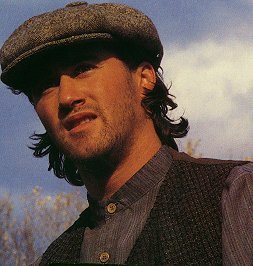 Ovila Pronovost...
Ovila Pronovost...What Roy did with this character is showing us how great an actor he is. Ovila was born with him. Of course the author has created the character but Ovila Pronovost will remain the work of both Roy and Beaudin. A long and arduous achievement as filming of Les filles de Caleb has lasted a whole year. One year, a complete cycle of Nature, four seasons, which cover almost 25 years. Roy went through a quarter of a century in the life of Ovila. Starting 12 years younger as Ovila at 15 to finish, his face against the window of the train station at age 37, ten years older than his real age (27).
I can imagine this is quite an experience for an actor to follow a character for such a long period of time. From teenage to
manhood in his last thirties, to immerse himself totally in someone’s else life ; quite exceptional. To share his dreams,
sorrows and passions for a whole year, what a privilege !
Roy was Ovila and he will always be him...He is part of our imagination. Ovila became a very important character of Québec life, because he is a symbol, a reference. He is a Québécois at the beginning of the 20th century, a voyageur, « un coureur des bois » or woodsman, who is not as yet civilized enough to work the land or to become urbanized. He is a rebel that even love cannot tame.
To live in Québec, from early 17th century until recently, someone needed a lot of courage, a little madness and above all an insatiable thirst for infinite spaces bringing with them its torments and all its greatness. You had to be someone like Ovila to survive, strong, robust and in good health ( I remember his mother telling him that he had received more than others...adding " You will build your life the width of your shoulders, everybody knows that "). To live in such a tough climate, facing winds and snow, a country of lakes and forest where unforcasted weather can surprise you savagely, a land where distances are infinite and solitude always present. Sometimes imagination is often the only solution if you want to continue the adventure. Ovila is still primitive and jealous of his freedom. He is the reflection of the land where he was born.

I believe that we are the land where we come from. The soil and the climate are making the people as well as a country.
Ovila and Émilie, like all the Québécois, including myself, are the image of the country. Our mind is rebel but our soul
is generous. This was and still is the essence of our survival.
Ovila, despite his impressive stature is a fragile man. Because everything touches him so profoundly. He then becomes defenseless against life’s vicissitudes, as any events that may occur will affect him, sometime it could be fatal and would leave him in darkness, blinding him from the joys of living. That is why Ovila could only be played by an actor who is able to render all the tones and moods of the character, like a painter with a most colorful palette, using the right color for the right scene. Someone strong enough to face off Émilie. Roy had this strength and the light inside him. He was a marvelous Ovila as I expected him to be.
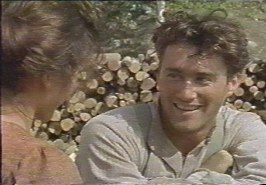 Ovila as a teenager,
Ovila as a teenager, How Roy played the role of a shy teenager in love. Well, he used his look ( his eyes are often wide open, a sign of innocence).
He also used his voice, which was a pitch higher than his own, and naturally with his whole body showing the uneasiness
of a teenager’s body to move around graciously.
Young Ovila is an introvert, and consciously or not, Roy has played him this way. The way he walks, he sits down on the school bench, with his head down, lying all over his desk in a protest, or to express his jealousy (especially during the school inspector’s visit, his potential rival). Always sitting in the background in the family kitchen, or near the fire place, staying away from the others, but always watching what was going on. He is already a solitary person who stays away in fear of getting hurt.
That will not stop his brother Ovide to make fun of him, and even challenge him for Émilie’s favors. The fight between the
two brothers are beautiful scenes that I love so much. Either taking place in the kitchen or outside in the snow, the feelings
of jealousy, rage, weakness...the stunning light of their green eyes...Patrick Goyette’s eyes are so close to a golden green
while Roy’s eyes are more a jade color and in both cases a little washed away by the strong emotion. Ovide is a beautiful
character although life did not give him any privilege, forced to play second fiddle because is lacking the charm of
his younger brother, also his strength and stamina.
I took some time to try to understand the relations of Ovila with different family members and what attitude Roy was
bringing up to his character through each member. Ovila is the fourth child of the Pronovost. He is the wild one.
We can say that his relationship with his elder brother, Edmond, is distant, the one with Ovide is competitive and
with his sister Rosée, simply affectionate.
Ovila is more at ease with the younger ones. Eva will often defend him. Lazare needs him. Handicapped by an illness, he will find in Ovila everything that he has been deprived of by nature, strength and energy. There are also physical differences, Michel Goyette was not very tall, even a little skinny, blond hair and a pale complexion. This again will amplify Roy’s healthy image, the one with broader shoulders, greater physical strength. Émile, Oscar and Télesphore when younger are often perched on his back, because he is the big brother, the strong tree, that’s their way to show him how much they love him. But Télesphore seems to be his favorite. The younger brother with blue eyes with shining dreams in them, like a mirror, as tender and caring as he is.
The relations with his mother are also very strong, with love and understanding. Being knowledgeable of his kindness as well as his weaknesses, she always protected him against untimely criticisms, and always said nice things about him. " He is my boy, I know of what he is made of ". Félicité is pure wisdom, and all the lines she deliver are like an anthology of the wisdom of the land, she is attentive and generous. Roy and Véronique Le Flaguais complicity in their relationship of mother and son was a happy one.
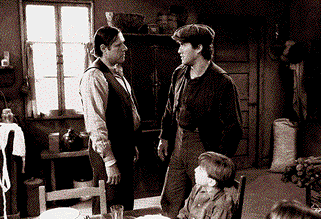 Ovila and his father
Ovila and his fatherDealing with his father was more difficult. The father being more responsible, and firm in his decisions. A man hiding his feelings to protect "l'ordre des choses " which means "the way things should be." Ovila is the opposite, impetuous, excessive, : he loves his father but he suffering knowing that he can not deliver to his father’s expectations. Worst, he will deceive him again and again, up to the point where he will be disinherited, being judged too irresponsible. Ovila will be marked for life beause of the lack of father
and son relationship which is a characteristic of many men in Québec. It is not an isolated case and it is often noticed in
our litterature and our drama. So I am not surprised to see it happened in this story : the male hero having the same problem
of a vast number of Québec males.
Nevertheless, Ovila’s family is very fond of him and the prove it when they welcome him back home after he has been away for a few months. It was a very warm scene, when everybody will embrace him, but at the same time, you will notice his father gesture who is trying to hold him back, pulling him against him in a blunt manner, so he would not run away again. Roy will move back, imitating a boxer on the defensive, his forearms near against his face. A fraction of a second, a look of disapproval in his father’s eyes. Then they both share their joy to be together again.
The Pronovost family is profoundly happy together. Roy and Ovila come from the same mold, Dupuis and Pronovost of
the same flesh and blood.
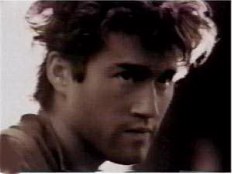
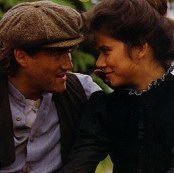
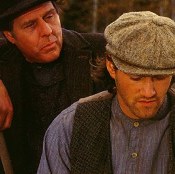
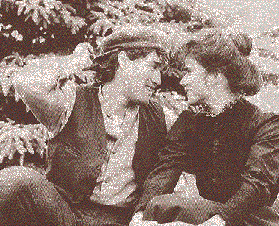

Émilie and Ovila
Tormented souls consumed by a burning desire.
The images on these pages represents an accurate vision of what their lives would have been and what really has happened, at least in the story. That's instant photography revealing the past and the future. They look at each other straight in the eyes, without defiance, without protection, both at the same level. But later on, Ovila will often show a loser face in front of Émilie, one of a helpless but regretful soul. But on this particular picture his look is greater than Émilie look, showing a total happiness, while Émilie seems to be wondering, uncertain of the future. She is holding a basket full of eggs, evidently showing what she will have to protect for the rest of her life; her children representing everything that she will ever own. Ovila holds his axe in his hands, his symbol of freedom, the key to his success. The axe represents the bush, his domain and shelter against the misfortunes of life. That's what he will be sharing all his life: between his love for wilderness and his desire to be near Émilie and his family.
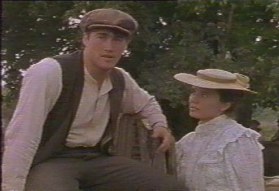

The best moments that they have spent together was during their stay at Lac à la Perchaude, in a log cabin built by Ovila; this was like the bordering of their universe. It was their secret refuge which I visited, feeling each object from the turtle stove to the hay mattress, plates on the table, the mirror on a wall, where they lived happy and secluded. Standing in their love den, lit by the August light, I have caressed the rough log walls, feeling the grass stuck between the logs and used as insulation. Remembering Ovila's looks trough the eyes of Roy, eyes darkened in the shadows, hiding their beautiful green color but so much enhanced with emotions.Ovila's fiery eyes lit by his burning desire, and their brightness after the appeasement, and the peaceful glimmer when holding her in his arms. And then I would recall his looks full of sorrows, trying to give Émilie some comfort after Charlotte's death and of his father as well as Émilie's father. This small log cabin on the lake was a peaceful shelter...where they really communicated with each other...and when they stopped going back there, it was the end of their romance.
Every love scene of Émilie and Ovila are precious because it is a counter part for the failure of their relation. These scenes will alternate with their most difficult moments, their misunderstandings, their heartbreaks and this is where we are able to admire Roy and Marina mutual energies. The way the touch each other, of caressing with a simple gesture, the way Ovila loves to do it when he brushes tenderly with the back of his hand Émilie's cheeks or when she runs her fingers through his beautiful curly hair, gracing him with her hand on his neck. Simple gestures that will create eternal links between them, and by contrast will cause pain and torments during their days of disputes or when Ovila goes away. We also felt lonely when he went away, sharing the same feeling of Émilie, thus creating the magic of imaginary becoming reality. The success of a story is when the public or the reader becomes part of it, living with the characters the same emotions. So I will longing for Ovila, the same way Émilie did. Then, it's mission accomplished and the work was a success.
It becomes an adventure when the spectator goes through the same reaction of the actors. Roy, Marina and the others, have taken us throughout the labyrinth of the lifes of their characters. It is powerful...I am fascinated; am I someone special? As I will feel the same magic, each time; the possibility to create a real world of fiction and the potential to be able to live emotions in a fictitious environment. Thanks to the actors who made it possible. Again it's magic...
In this TV series, some scenes are part of Québec anthology. One of the scenes shows the mating of horses,
which is echoed in the gestures of Émilie and Ovila.
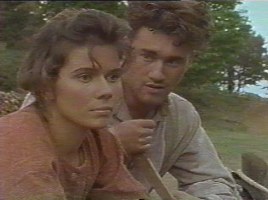
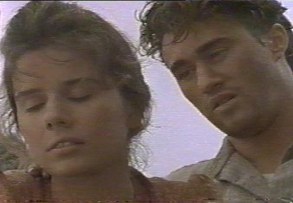
Marina is leaning against a fence, Ovila standing besides her. Their body's expression, Roy's lateral approach, lightly leaning against her arm, both staying watchful of Émilie's father. With his arm, he pushes against the fence, squaring off his shoulders, moving his head forward, slowly, as a stallion showing his strength. Émilie caresses her shoulder with her chin and straighten out from her leaning position, waiting. While Roy is scrutinizing for any intruders, he then position himself behind Émilie and make a move quite unconventional in those days and which became famous throughout the Province.
The look in his eyes when he was caressing Émilie's neck, that I never seen again. Ovila would have been holding the Holy Grail in his hands, he would have had the same emotion: he was transfigured, time had stopped... Again with a simple gesture, its authenticity, Marina was answering him, her eyes closed, enjoying each moment. It became the most sensual scene on Québec TV that Roy had given us. The power of the eyes, the expression on a face and of the whole body, become a strip-tease of the soul. Without taking off one single piece of clothing. Roy is a virtuoso in making the characters he is playing flesh and blood either on the stage or on the screen. Few actors are able to go that far in transmitting the pains or the joy of living. I believe that he has an inner power to master the greatness of beings touched or blessed by grace...He is gifted, and he was conscious of this even when he was younger, so it grew up in him and finally gave us so many happy moments. He is like this beautiful instrument that will surpass the beauty of the work that it is playing to ask our soul to join him... It is in the communion between the performer and the listener that happiness will be revealed...
When I watch him play, I do not see him play, I watch him live...
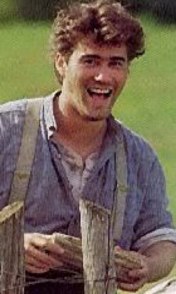 Ovila... The land and the woods
Ovila... The land and the woodsWhat makes Ovila most interesting is the deep rift inside him.
Because he is a strong boy, he is the only son his father can depend on to take over the farm. He is a work horse. His stature challenges the land which is asking to be opened up. His strong body needs a hard labor, and in fact, he is fitting exactly the shoes of the sower and the plowman. But Ovila deeply hates the farm.
In vain he will try to fight his aversion because he loves his family which is telling him to stick to it. And, Émilie comes in his life, and his own children : and then everything will add up forcing him to remain on the farm.
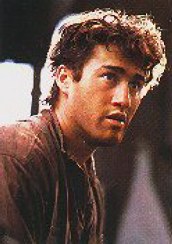

He will spend his time with the ones he loves, salving away, being happy, not happy of what he is doing but in feeling the love of the ones he cherished...and then he will run away deep inside of him, in his dreams, in a lonely and far away flight. For him freedom is spelled : woods even if it is not Eden. But at least he feels that he will not be treated as cattle. After a while, he will become lonesome, bored and be longing for his family.
I feel that his problem whit alcohol comes from this duality inside him that he must fight all the time. The impossible sharing of his own nature with what he is supposed to be and what he should be for others.
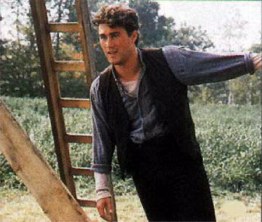 I wonder what exactly was Roy’s motivation before he decided to take the role. But he achieved his goal marvelously and in a subtle way. Ovila is not an easy character. Roy could have rendered him as a depraved, irresponsible, selfish man, giving him only his beautiful physical attributes and making him a coward, a wear and a despicable character.
I wonder what exactly was Roy’s motivation before he decided to take the role. But he achieved his goal marvelously and in a subtle way. Ovila is not an easy character. Roy could have rendered him as a depraved, irresponsible, selfish man, giving him only his beautiful physical attributes and making him a coward, a wear and a despicable character.Thanks to Roy, we cannot hate Ovila. In fact, he made him a better human being. With strenght and softness in his gesture and the look in his eyes...slowly, imperceptibly he has woven between Ovila and the spectator a delicate web of affection and compassion. We were then ready to accept him and to love him with his joys and his moods.
Berthe (Émilie’s best friend) perhaps describes Ovila in a most proper manner when she tells Émilie, after the horses scene, « Have you seen him work when he was separating the horses’...he is strong and delicate. That’s rare... » She was right. And this will also apply to Roy’s talent. Being talented in both a positive an or a negative situation. Ovila’s distress is only equal to the astonishing beauty of his moments of happiness. And because of Roy, we are able to feel the distance between theses two feelings and to measure its complexity
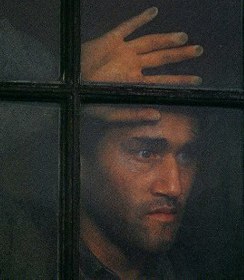 Ovila...
Ovila... 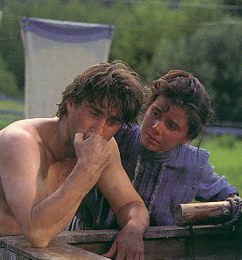
The fragility of the soul
My first observation of Ovila’s character is that he is most vulnerable. You could feel it in the novel as well, but Roy’s interpretation of the character made it more tangible, in fact Roy gave it life.
Imagination is a territory that can be explored. But for an image to remain imprinted into memory, it is better when seen by the eyes. Sometimes, just imagining is not enough. Few novels will imprint the memory forcefully enough to leave an indelible mark. It is up to the actor to do that, by investing himself entirely, to become one with the character who will borrow his voice, his own breath, in fact his body and soul. Only then will he cross over the glass wall to come to life.
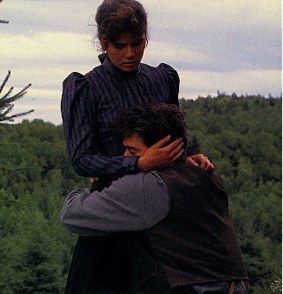
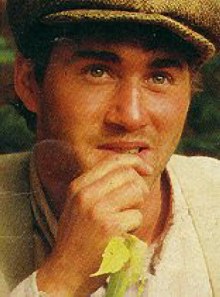
Roy made this happen many times in Les Filles de Caleb. During some love scenes as mentioned earlier and also in more dramatic, tragic scenes where pain and agony were of paramount importance.

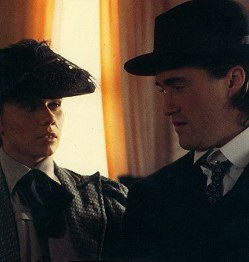
I have in mind of few samples. The first fight between Ovila and Émilie when they returned from Montréal. Ovila learns that his job contract has been canceled and that he must leave for the camps. Émilie becomes sad, frustrated even hasty...Ovila is down and heads on for the Grand Nord’s bar from where he will return drunk and desperate. And this was not enough ; his brother Ovide will announce the death of his young brother Lazare.
What a beautiful scene ; it is the crack of dawn, you could feel summer, in their small bedroom, which walls have been painted red as the blood of a bull...this scene shows Ovila’s hit for the first time with a major crisis. Through Roy’s brilliant look in his eyes, his desperate laugh which will bring tears, sobbing, lying on the bed, his face hidden in the bed sheets, with open fists and
his heart wounded, wide open.
The second scene is when their daughter Louisa passes away and this will cause even a larger wound. Most difficult to render. Again it is with the look in his eyes that he will express his heartbreak and the torture of his soul. That is the scene shown in slow motion when Émilie will join Ovila in the children’s bedroom. She will stare at him trying to understand the terrible impact of this drama on him and to catch in his terrified look a glimpse of his grief and his tears. Horrified, she will take the child away from him, pushing him back.
Émilie’s gesture will hit Ovila cruelly like a second wave of an earthquake. He backs up with the shock, feeling abandoned, powerless and horrified. An the following scenes are made in the same dark atmosphere, showing Ovila distress, left by himself without Émilie’s support, drifting away, wounded and drowning in his sorrows. Another moving scene is the one where he is sitting at the kitchen table, face down in his right arm, like a child, his own mother’s hand touching his neck will be his only comfort ; it then becomes a very heavy atmosphere. And what about the next day, when he will see Émilie, still asleep and who can hardly wake up, being sure she’s having a bad dream when he shows up, beaten, destroyed by a night of horrors. Roy does not say a word during the scene but his silent interpretation is worth more than many words he could have said...also how he covers up Émilie, who bursts into tears in his arms, rocking with her, trying to appease their immeasurable pain.
To conclude, I must add the scene after the burial. In a framing that reminds me of a painting of Vermeer or Georges de la Tour, Émilie stands up front, dressed in black, her harsh face illuminated by a faint light coming through the window, her eyes dried out with a look full of hatred. The entire room is plunged in darkness. What a beautiful analogy. The color of their love in mourning. Ovila is standing on the doorsteps, then he will start coming to her, trying to understand. His face is distorted, his look heavy. Without looking at him, she is accusing him, making him responsible for the death of their daughter and pushes him out of her life. Ovila remains helpless, digging himself deeper and deeper. When I was listening to Émilie, I kept watching Roy.
His eyes were full of sadness and tears which were stopped up by a dam, with difficulty to breath, choked by emotion like a tormented wind in his soul. He tries to soften her by saying : " But I love you..." Émilie stand there immobile, walled in her resentment. Ovila will leave and this will be the beginning of hell.
As a third example, I have chosen the scene where Ovila will, in a desperate way, show his hatred for the farm. Being a father of seven children, Ovila is condemned to the farm in order to feed his family. But he can not face it. This is a precious scene when he will express without a doubt his own shame and the end of his dreams. After a serious binge at the Grand Nord, Ovila returns home. The next morning, he goes refreshing himself at the well behind the house. As he comes back to reality a slow and insidious resentment invades him. Émilie finds him beating himself up with his damp shirt and damming himself.
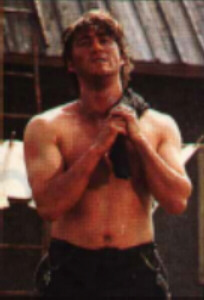

With his elbows against the edge of the well, holding up his head with his two hands under his chin, he will blow away his hatred of the farm : « I hate you...I hate you « And that’s coming from the bottom of his heart, as well as his tripes. The wild nature moaning and groaning under his responsibilities. The wild animal that life is trying to harness, is desperately crying for freedom. Ovila’s despair is deeper than the well he is leaning against.
But under all those terrible events, the scene that represents both Ovila and Roy at their best is the one after his brother’s death, the young jeweler. Ovila has always been very close to his younger brothers, so Lazare’s death was a tough moment,
Télésphore’s was intolerable.
It starts when he rushes in the family home, then involved in prayers, wanting to know how was Télésphore and up to the scene where he holds his dead brother in his arms, refusing to admit the inescapable. Roy breathing with difficulty, showing the pain going inside like a dagger piercing him, following by this terrible scene in the workshop where Ovila being incapable of restraining his pain, in a rage will destroy Télésphore display cabinet, slamming it down with the same tool he had built it with so much care and love. His screaming and yelling, his tears, his body sinking along the wall, knocking the back of his head against it and the door frame, so hard that it blew my heart up and for sure Émilie’s also, who will hurry up and take him in her arms....
Such of description of life and of all its moods is surely Art. To render life from its finest state to its
darkest moments is truly a gift of God.
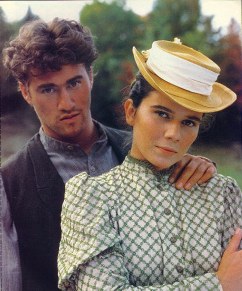

Émilie and Ovila became here a legendary couple, filling our lives for 20 weeks throughout the province. In the fall 1990, Québec population was nearing 6 millions people. During that period, Les Filles de Caleb had a rating of 3,320,000 viewers every week. If you compare this with the US population, it gives you a figure of 150 millions or 20 millions more than the last Super Bowl (130 millions/30-01-2000). It’s a lot of viewers. Everybody here in Québec watched Les Filles de Caleb. When such a phenomenon occurs, it is more than just a TV rating, it is like a cultural movement of an entire society which will remain in our tradition.
Roy was carried by this wave and landed on the shore where famous people are. With this major role, he left forever the world of anonymity. His good fortune pushed him under the spotlight, where his talent and the strength of his team have created a beautiful piece of Art.
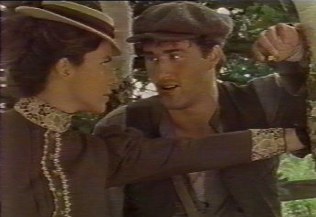

To Jean Beaudin and all the artists and craftsmen of Les Filles de Caleb our greatest admiration for their achievement : giving life to words. Thanks to them, Ovila and Émilie and the rest of the cast have reached the top...they became a portion of eternity.
Then the soft and velvet look of Émilie will be inundated forever by the green and sumptuous light in Ovila’s eyes.
